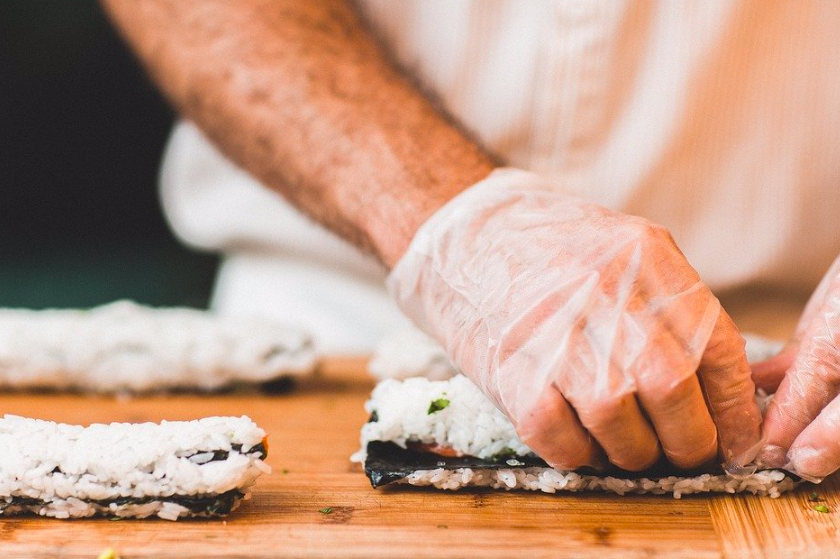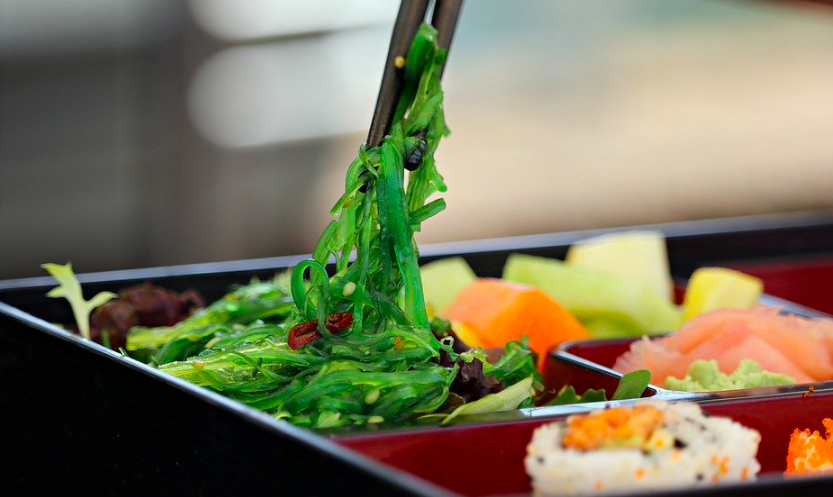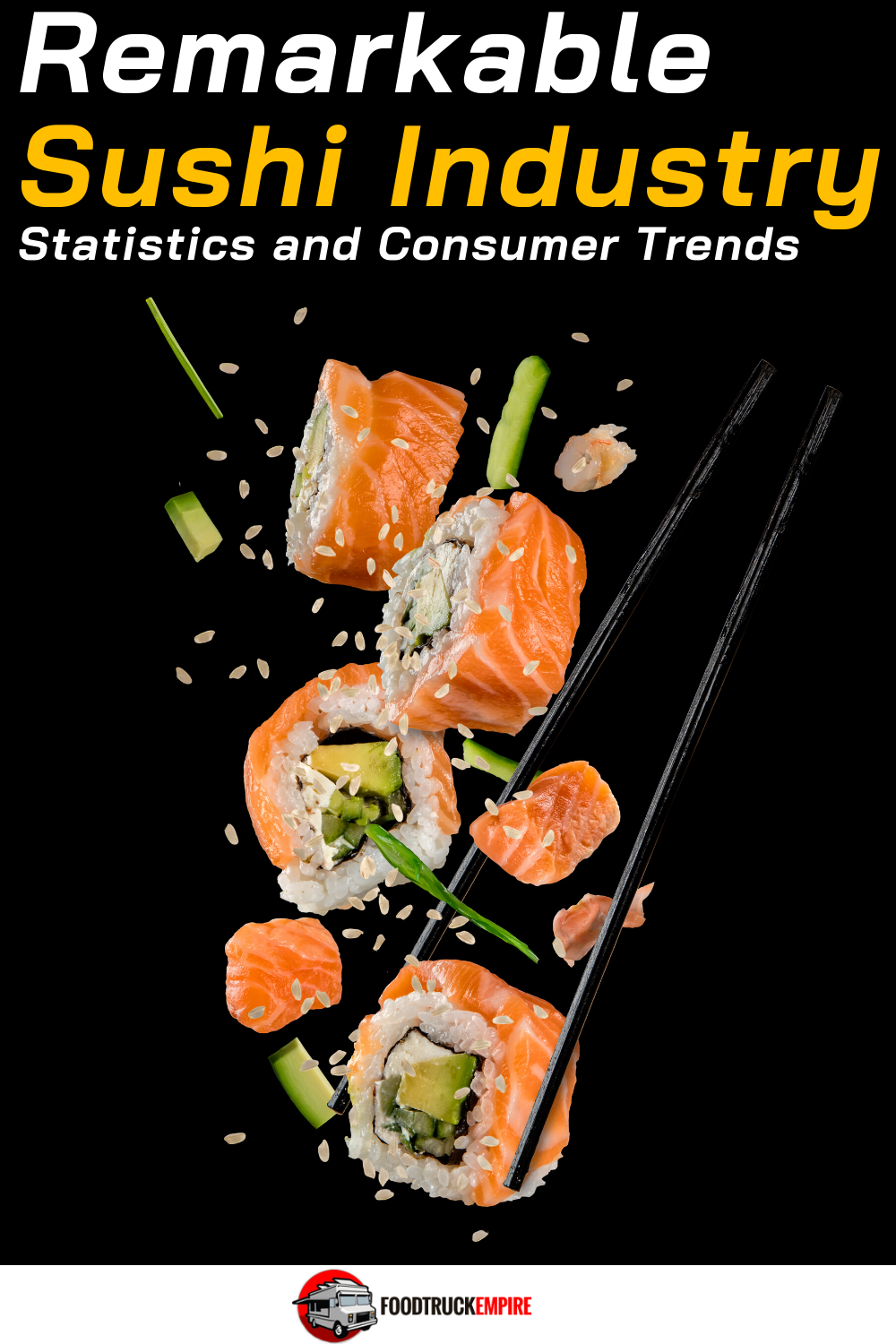Sushi is a Japanese food that has been enjoyed by 62% Americans. According to a survey conducted by Pei Wei, more than half of the people in the United States that haven’t tried sushi yet would be willing to give it if the opportunity presented itself.
Sushi is one of the oldest traditional Asian food that was able to make it to the mainland around the middle of the 20th century. Americans did not initially embrace Japanese food and culture in general due to Japanese resentment after World War II. But Americans have embraced this dish now, especially if you live on the West coast where 80% of residents have enjoyed the meal.
Today, sushi is a $22 billion dollar industry with over 4,000 sushi bars scattered around the country. Meeting up with friends for sushi is akin to inviting friends for beer and pizza nowadays. In today’s industry report, we evaluate how the sushi industry has shaped up throughout the decades and where it’s headed next.
Sushi Stats and Facts

California rolls being rolled.
6.72% of restaurants serve sushi on their menu. (TasteWise)
A lone cut of sushi roll of about 6 to 9 pieces can contain as much as 500 calories. (Time.com)
Store made sushi eaters are primarily in the age range of 25 to 34, followed by those under 24 years of age, while those who are between the ages of 35 to 44 are on a close 3rd spot. (Numerator)
Sushi is usually considered as a weight-loss-friendly meal. (HealthLine)
Sushi and sashimi typically come from 80% of fresh bluefin tuna caught around the world. (Fact Retriever)
According to a survey, about 94% of those who want to try sushi would avoid consuming raw fish. (Kelton)
The average sushi consumption per consumer is at 2.64 per year. (TasteWise)
83% of sushi generally has a low bacteria count. Consequently, consuming frozen and fresh fish does not pose a health risk as long as proper hygienic standards are practiced. (FreshMag)
Consuming a spicy shrimp roll complete with seasoning contains 550 calories. (Time)
The ethnicity of those who consume store-made sushi is generally Asians followed by Hispanics. (Numerator)
Related Reading: 43 Breakthrough Kombucha Facts and Industry Statistics
The sodium and fat levels can rapidly increase when using sauces and dips in your sushi feast. Spicy mayo, for instance, has a robust content of calories and fat. (Time)
Opting for brown rice instead of white rice into your sushi can escalate your nutrient absorption. (HealthLine)
A single serving of sushi adds up to a low-protein and low-fiber meal as it contains minute amounts of vegetables or fish. This, however, does not serve as a full meal as it does not diminish appetite and hunger. (HealthLine)
American Sushi Market

Seaweed salad is a popular side dish at sushi bars.
If you live on the West coast, you’ve probably enjoyed sushi on many occasions. If you live in the Midwest, only 55% percent have tried this imported delicacy.
There are close to 4,000 sushi shops scattered around the country today with yearly sales grossing at around $2 billion. (MentalFloss.com)
Sushi restaurants in the U.S. are expected to grow at a rate of 1.7% in 2020 (pre-pandemic figure). (IBISWorld)
Approximately 99.99% of sushi rice served in local restaurants is also grown domestically. (Fact Retriever)
Going out for sushi is now synonymous with meeting up with friends for beer and pizza.
According to a survey, about 1/3 of Americans have never tasted sushi though 3 out of 5 of them are willing to try it. (Kelton)
Grasshopper, Chili, Selles-Sur-Cher-Cheese, Coconut Milk, and Bee Pollen are just some of the sushi flavors gaining popularity in the market. (TasteWise)
The market size of sushi restaurants in the country is expected to reach $22.1 billion (pre-pandemic figures). (IBISWorld)
The world’s longest sushi roll was made by a Japanese entertainer, the tourism ambassador of California with some help from Japanese tourists in 2005. (FreshMag)
The healthy lifestyle boom in the 1980s made sushi popular among Americans. (Fact Retriever)
About 62% of Americans who never tried sushi are amenable to try one, while 43% of them are fine with eating sushi as long as they stay away from consuming raw fish. (Kelton)
Starting a Restaurant? Download My Food Business Model Canvas with Template
Los Angeles is considered to be the birthplace of authentic Japanese sushi, according to Trevor Corson’s “The Story of Sushi: An Unlikely Saga of Raw Fish and Rice”. (MentalFloss)
The top consumers for store-made sushi include people in the $125k and over income bracket followed by those in the $20k-40k bracket. (Numerator)
The U.S. sushi market is expected to augment with an annualized growth of 3.8% from 2015 to 2020 (pre-pandemic figures). (IBISWorld)
Global Sushi Industry Statistics

Chop sticks and sushi plates.
The global sushi restaurant market is anticipated to grow at $6.40 billion from 2018 through 2022 (pre-pandemic figures). (TechNavio)
Industrial advancements are determined to be one of the drivers in the growth of the sushi restaurant industry. These improvements are believed to enhance tailor-fit promotions among other benefits to the sushi industry. (PRNewswire.com)
In a report from NPD Japan in 2018, the conveyor belt sushi (more popularly known as rotation sushi or the sushi train) market size in Japan is valued at around 640 billion Yen or $6.4 billion.
Some of the key players noted by the Sushi Restaurants Market report, and in no particular order include Kura Corporation, Sushiro Global Holdings, Genki Sushi, Peace Dining Corporation, Kura Corporation, and Hamazushi. (Piece of Japan)
The sushi market global market is heavily divided as the market share is made up of a multitude of players. (TechNavio)
For 6 years from 2010, the conveyor sushi belt market grew by 150%. Though since then, market growth has decreased in the succeeding years. (Piece of Japan)
The increased popularity of Japanese cuisine is determined to be one of the factors driving the growth of the global sushi market, according to a report. Consumption of Japanese food is believed to bring health benefits. (PRNewswire)
Intensified marketing campaigns are also determined to be a major factor in the growth of the sushi restaurant market worldwide. Outlets are now using the power of social media as well as traditional print media to promote their store and products.
In a market study, 77% of the global sushi growth is expected to come from the Asia-Pacific region (pre-pandemic estimates). (TechNavio)
According to a report from the Japan Foodservice Association, the sushi market amounts to 1.5 trillion yen. The conveyer belt sushi makes up 43% of the whole sushi market. (Piece of Japan)
One report says that rising demand for retail sushi and home-cooked are affecting the growth of the sushi industry. Increased awareness of nutritional intake steers most consumers to go for home-cooked rather than cafeterias and restaurants. This is especially true in today’s world due to the pandemic. (PRNewswire)

Soy sauce is the most popular condiment served at sushi bars.
The Bottom Line
Would you believe that sushi didn’t originate in Japan? The said dish actually traces its roots in Southeast Asia over a rice-growing region near the Mekong River, a trans-border river between Thailand and other neighboring countries, around 2,000 years ago. It actually made its way into Japan only around the 8th century AD.
Noritoshi Kanai, an export manager for the U.S. and Japan, opened the first recorded Japanese restaurant in Little Tokyo in 1966. He sought the assistance of a sushi chef to help start and operate the restaurant. However, finding an acceptable fish for their menu was an obstacle at that time. Thus, the fish was directly imported from Tokyo which was very inconvenient during that time, and the rest, as they say, is history.
Today, the sushi market is a billion-dollar industry both domestically and globally. Prior to the pandemic currently being experienced globally, sushi was projected to grow steadily by $6.4 billion through 2022 fueled by enhanced digital marketing to further promote the product.
We expect this industry to continue growing into the 2020s as more people in middle America continue to discover and enjoy this imported dining option. In the Midwest, more all you can eat sushi joints that allow customers to experiment with different rolls and flavors is recommended.





